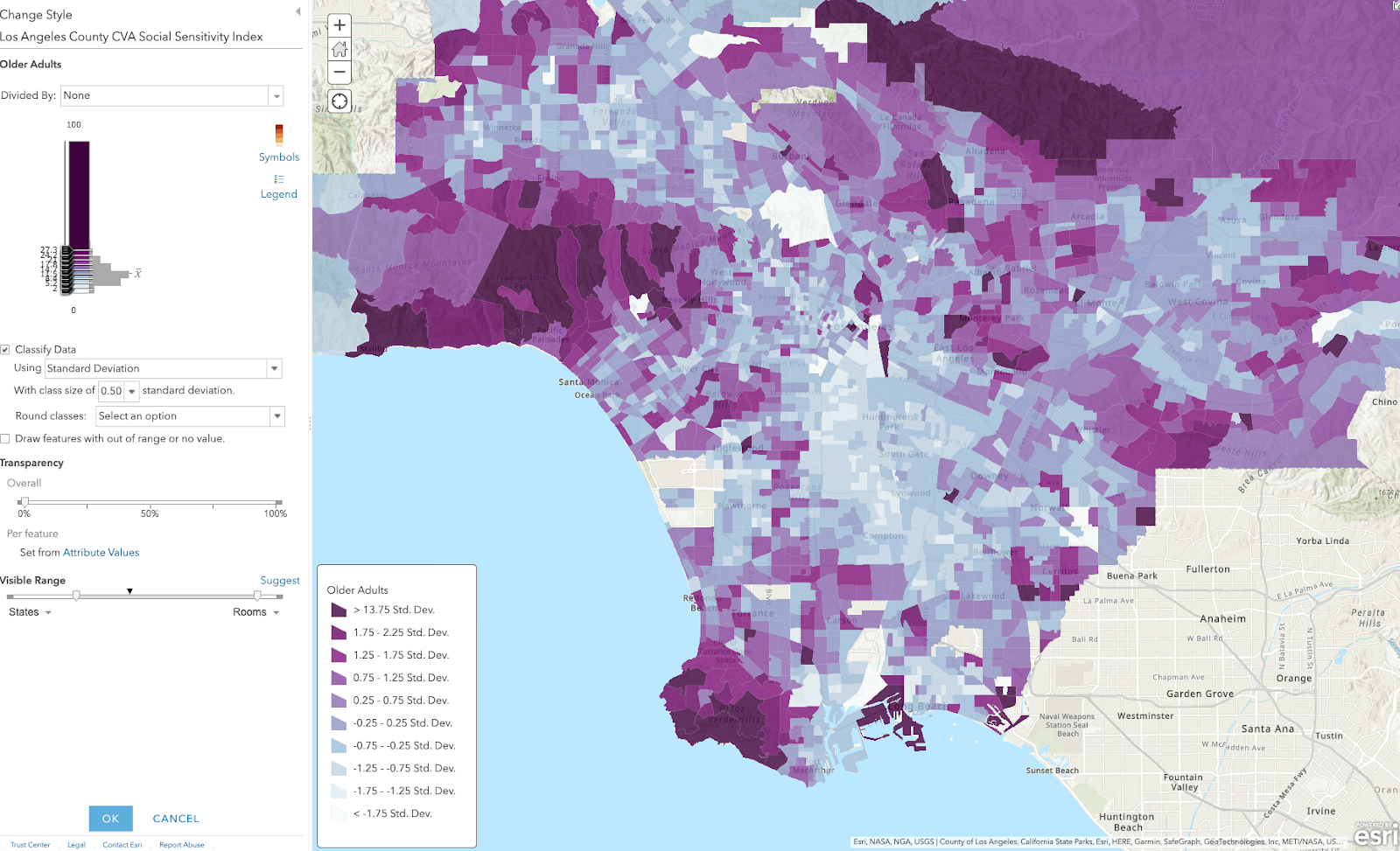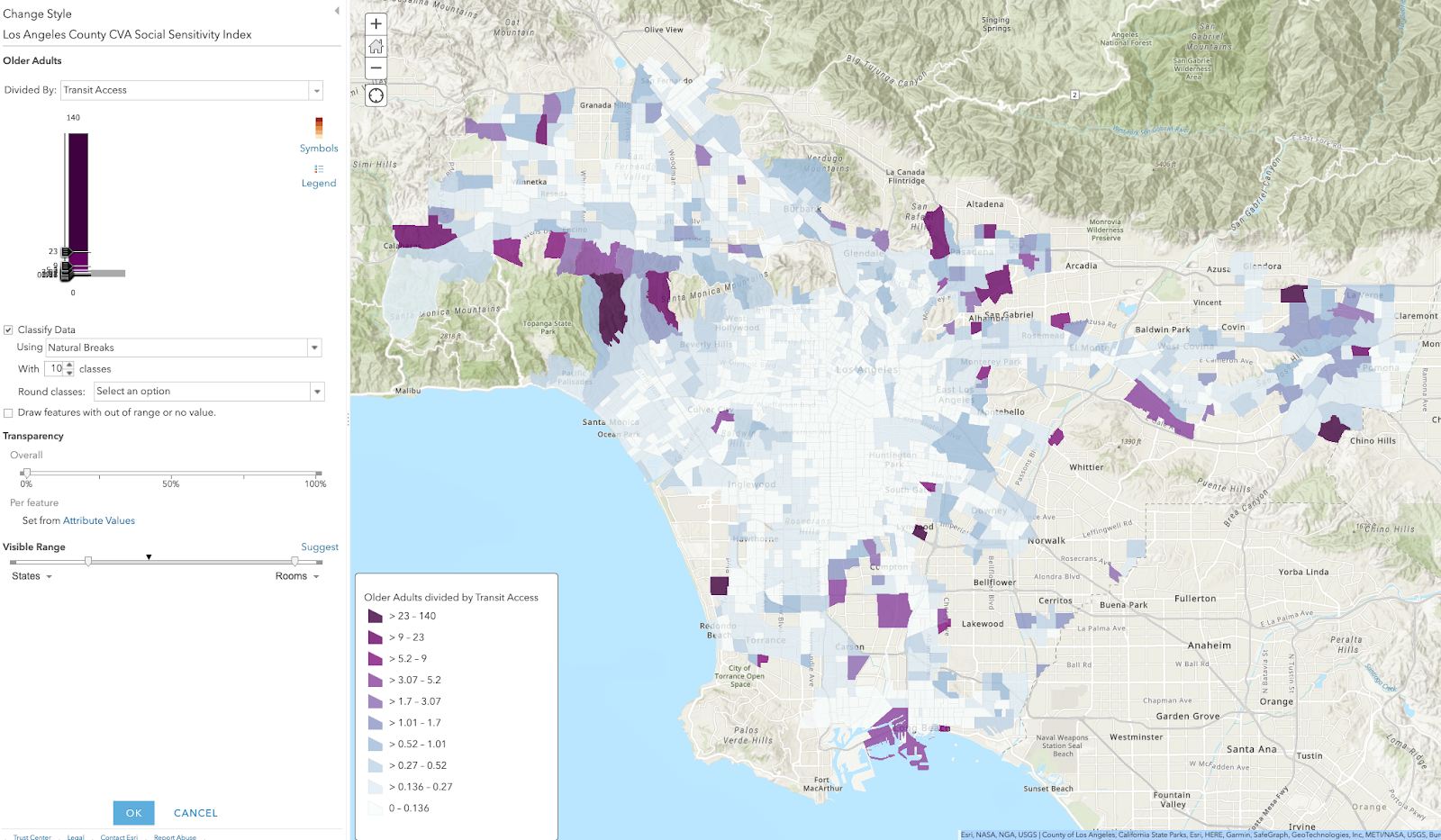- DTLA (cordon area)
- I-10 between Santa Monica and DTLA (toll road)
- I-405 through the Sepulveda pass, including canyon roads (corridor pricing)
I wrote an analysis from a data-based and science (climate change, pollution) perspective, and encountered a lot of pushback. Everyone in the group is a driver, but I'm the only utility bicycle rider that rides in traffic. Others ride recreationally on the beach bike path or on low-traffic foothills roads.
The reflexive response was, "What about the low-income (or moderate income) drivers?"
I was making maps using data from Los Angeles County CVA Social Sensitivity Index and was struck by how some areas of LA County are much older than others. That is, the coastal and hill sections have extremely high proportions of seniors. It's especially dramatic if I map the census tracts by how many standard deviations they are from the mean.
Darker magenta areas have more people over 65 years old than average. Bluer areas have fewer seniors.
By implementation time for congestion pricing, today's 65 year olds will be > 73 yo. How long do you think they will be able to drive mountain roads?
It gets more grim when I divided by transit access. These are high senior population percentage divided by standard deviations from mean transit access (which is already not great in LA County).
This leaves some voids in the flatter areas, which can be fixed by street space allocation, improved bus service, and some apartments near bike lanes & bus routes (hello, East Manhattan Beach).
Anyway, congestion pricing is not going to harm seniors living in the canyons of Bel Air, Malibu, or Brentwood. They will soon age out of driving. It might cost them more to receive senior care in their homes if their caregivers have to pay to drive there.
On the other hand, if it does improve traffic, then lower income workers will have more time for paid work and less unpaid time sitting in traffic. E.g. they can accept more clients per day because they will spend less time driving. This starts a virtue cycle where they won't have to pad their per visit charge as much, making senior care more affordable.
You know what would create less traffic? If we let seniors live in congregate settings, where they each have their own small apartments, but caregivers are on site and can simply walk between clients. That would help alleviate traffic, the shortage of elder caregivers, and improve caregiver pay per hour.
Instead of thinking about changes with fear, look critically at what is not working and how we might improve the status quo.


I really appreciate how you think about transportation.
ReplyDeleteThank-you
DeleteI have been bicycling to work daily from North Redondo to El Segundo for 13 years and no accident. I save car, gas, insurance, pollution and gym money, so I can retire earlier. We are just ahead of the younger crowd.
ReplyDeleteI witnessed my mother-in-law age in an area of Washington State where public transportation is a joke, which is still true for most of the state. She already couldn't drive on the highway in her 70s, then couldn't drive at night as she approached 80. Her health started to seriously decline as she entered her 80s and by 84 became a prisoner in her own home. She became isolated and depressed due to her lack of mobility. Also her car (payments+gas+insurance+maintenance) ate up a good chunk of her fixed income, adding more stress to the already unhappy situation she had found herself in. I grew up in NYC where this scenario is unimaginable. Watching my MIL made me realize how unreasonable our car culture is for all the various stages of human life. My MIL would have benefitted from living in a place like NY where she could have gotten around easily by bus/train and the occasional cab. Of course this was all before the advent of ride-hailing apps but those services alone would have been too expensive for my MIL and I believe for many other seniors who live with a tight budget. Effective, affordable, and safe public transportation needs to be an option for seniors. I anticipate increasing transportation-related problems as the silver tsunami approaches. Thank you as always for your thoughtful posts.
ReplyDelete